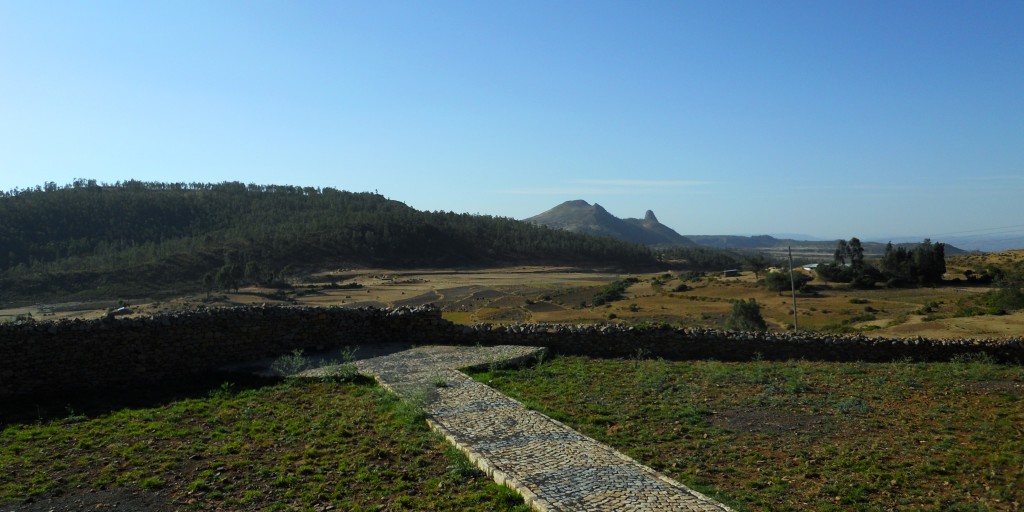The Language Nerd is doing a series on Ethiopian linguistics – intro here, then parts one, two, and three.
So throughout this little Ethiopian lingventure I’ve been mentioning Ge’ez and the Fidel. Ge’ez down to here, Ge’ez out to there, Ge’ez to where it stops by itself. It’s about damn time that I gave it some specal attention.
Ge’ez is a language that was used in ancient Ethiopia, in the Axumite empire. The Axumite empire was kind of a huge deal, one of the three superpowers of 600 AD, full of ivory and spices and amazing hats. It started out around – you guessed it – Axum, growing from an even older civilization called D’mt.
Ge’ez is the language; the script, the writing system, is Fidel. The Fidel got their start when a buncha folks called Sabaeans came over from Lebanon to hang out in the BC 700s, and brought their writing with them. You’ve heard of the Phoenician writing system being the first alphabet, getting passed all around the Mediterranean, settling down into Greek and yadda yadda yadda? Well, the Sabaean Sensation showed up in Axum even earlier, with a writing system somewhere between the Egyptian hieroglyphs and the later alphabet. The Sabaeans didn’t have much effect on spoken Ge’ez, but boy howdy, the Axumites took the “use-a-symbol-to-represent-a-sound” concept and ran with it.
The Axumite carvings are fascinating because, well, because lots of reasons, but what I love is that you can see writing systems connecting across time and space. Nowadays, if you look at the three scripts used in Ethiopia – the Fidel, the Latin letters, and to a much smaller extent Arabic – they seem completely distinct and alien to each other. But go comparing carvings from over a thousand years ago…

Ge’ez, Aramaic, and Greek, hanging out being ancient. (Photo credit: the Ge’ez and Greek are mine, from the Ezana column in Axum; the Aramaic is at the British Museum, photo by Mustafaa)
…and the shared history is obvious.
The Axumite empire rose and fell, as they do, but Ge’ez and the Fidel stayed strong, surviving into the later Ethiopian empire. The new emperors took it up and encouraged it in their courts, and by Medieval times there was a veritable ocean of Ge’ez literature. Dr. Mersha Alehegn, a philologist (ancient languages guy) at Addis Ababa University, says he’s swimming in the scholarship. He makes a rough guess of 250,000 known, accessible manuscripts in Ethiopia right now.
The total number is probably far, far more. See, Ethiopian monasteries have a tradition. When danger threatens, like when Muslim invaders came through in the 15th century, the monks pack everything up and hide it, often burying it in the desert. If the danger passes quickly, they dig their ancient texts back up and head home, but if it lasts longer than a generation or so, the texts stay hidden, sometimes with no one left who remembers where they are. Stumbling across a thousand-year-old manuscript in a cave isn’t a daily occurrence in Ethiopia, but it’s not exactly uncommon either.
Dr. Mersha and archivists like him spend a lot of time in monasteries, photographing ancient books, cleaning them, and trying to get them packed away safely. They’re in danger from fire, flood, and bugs, and there’s a special fund set up to try and get more bookshelves out there. Just getting texts off the floor is a big help.
As Ethiopia grew and Amharic took over, the strength of Ge’ez waned, but it found a niche in religion, as the sacred language of the Ethiopian Orthodox Church – hence all the texts showing up in religious places. It’s mostly used only liturgically now, though the Friends of Ge’ez Society are out there every day, amping it up. If anything, Ge’ez is more popular now than it was a generation ago.
Wait, were you expecting to actually learn how to read and write the Fidel here today?
Uhm, well. Hey, what’s that behind you?
Yours,
The Language Nerd
Got a language question? Ask the Language Nerd! asktheleagueofnerds@gmail.com
Twitter @AskTheLeague / facebook.com/asktheleagueofnerds
If you want to learn Amharic, the Omniglot site is a nice place to get an overview, and I like this site for settling in for learning. I also wrote a little about how the Fidel work as part of my discussion of writing systems here.
My main source for the historic bits is the National Museum of Ethiopia, where the knowledgeable staff was very patient with my questions, supplemented by Wiks. Modern archiving discussed with Dr. Mersha Alehegn in person.
This wraps up my trip to Ethiopia – in fact, I’m typing this at the airport. I’ll be back to the usual q-and-a format next post. Don’t be surprised if more Ethiopian bits pop up, though. I didn’t even mention that ancient Fidel were boustrophedon!
And, once again, I need to give a huge “thank you” to the linguists at Addis Ababa University, especially Dr. Zelealem Leyew, Dr. Binyam Sisay, Dr. Abebayehu Messele, Dr. Moges Yigezu, Dr. Mersha Alehegn, Dr. Ronny Meyer, and Dr. Derib Ado. It’s been an honor to meet you all and learn about what you’re doing, and I cannot thank you enough for your warm welcome and willingness to chat. Until next time!
